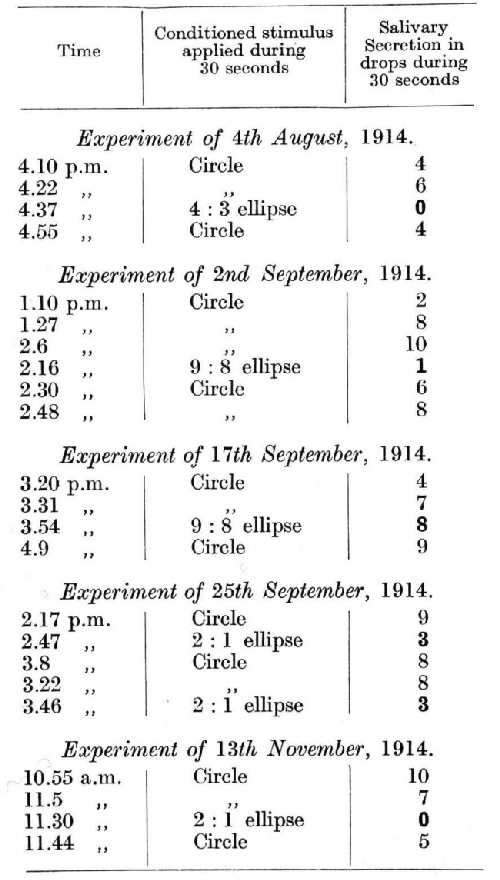
(Return to index)
Posted March 2001
[Classics Editor's note: Pavlov used both square and round brackets in his texts. These have been preserved but can lead to confusions as to which insertions are the author's and which are the editor's. Page numbers, reference numbers, and the occasional "sic" have been inserted in square brackets by the Classics editor. All other insertions (e.g., on p. 31) are by Pavlov. -cdg-]
LECTURE XVII
The different types of nervous, system. -- Pathological disturbances of the cortex, result of functional interferences.
We have been dealing up to the present with the normal activity of the cerebral cortex. It was noticed in passing, however, that the experiments to which our animals were subjected led in some instances to chronic disturbances of this normal activity. This was especially liable to occur in the early stages of our work, since in planning the experiments we had at first not even the slightest idea as to the limitations and the natural resistance of the cortex. The present lecture will be devoted to a description of those disturbances in the higher nervous activity which are of a purely functional origin, and not due to surgical interference or trauma. From some of these disturbances the animal recovers gradually and spontaneously under the influence of rest alone, on discontinuance of the disturbing experiments; in other eases the disturbances are so persistent as to require special therapeutic measures. In many instances we were able to make observations during the actual period of transition from the normal physiological state of the cortex to a pathological state, and then to study its therapy. The pathological state of the hemispheres in different individual animals from the action of injurious influences varies greatly. One and the same injurious influence causes severe and prolonged disorders in some dogs; in others the disorders are only slight and fleeting; while yet other dogs remain practically unaffected. In many cases the deviation from normal produced by the same causative agent assumes in different dogs quite different aspects. The type and the degree of pathological disturbance that develops from some definite cause was found in all cases to be determined primarily by the character of the individual nervous system of the animals. Therefore, before describing the different pathological states it is important to say a few words about the different individual types of nervous system found in our dogs. The systematic investigation of the higher nervous activity has enabled us to outline even at present certain [p. 285] definite criteria which when expanded in the future will lead up to an exact definition of the different types of nervous system of individual animals. Such criteria when perfected should greatly assist the development of a strictly scientific experimental investigation of the hereditary transmission of different aspects of nervous activities in animals. At present, however, I shall not go beyond a general classification of our dogs. Two definite types, which may be regarded as extremes, stand out with special prominence.
The first type was met with practically from the beginning of our investigation, and the researches on animals belonging to this type led in our early experiments to much confusion. At a time when we were still quite unfamiliar with the subject of conditioned reflexes, we met in some of the experiments with considerable difficulties on account of a drowsiness, which developed from the use of certain conditioned stimuli and under certain conditions of experimentation, and which we were not able to overcome. We thought to get rid of this drowsiness by choosing for our experiments dogs which outside the experimental conditions were very lively. Animals were selected which were extremely vivacious, always sniffing at everything, gazing at everything intently, and reacting quickly to the minutest sounds. Such animals when they get acquainted with men, which they do very quickly and easily, often become annoying by their continuous demonstrativeness. They can never be made to keep quiet either by orders or by a mild physical punishment. It was, however, soon found that these very animals when placed in the stand and limited in their movements, and especially when left alone in the experimental room, were the quickest to become drowsy, so that their conditioned reflexes quickly diminished or even disappeared altogether, in spite of frequent reinforcement by food or acid. Indeed, our repeated stimuli when they had not yet acquired stable positive conditioned properties immediately, and in a most unequivocal fashion, produced drowsiness and even sleep in dogs which at the commencement of the experiment were wide awake. [1] [p. 286]
In some animals this happened even when they were not placed in the stand during the experiments, but were left free on the floor the experimenter remaining quietly in the room; nevertheless the dogs on administration of a conditioned stimulus soon got sleepy, closed their eyes and finally lay down on the floor. This often happened immediately after the reinforcement of a conditioned stimulus. At first we despaired of achieving anything with these animals; later we learned how to get over the difficulties. In dogs of this type many conditioned reflexes must be developed concurrently, and with a great variety of stimuli; no stimulus must be repeated more than once in a single experiment, and long pauses between the applications of the various stimuli must be avoided; not only excitatory but also inhibitory reflexes must be developed. In short, when we make rapid and considerable variations in the experimental environment such dogs become quite satisfactory subjects for the experiments. It is an interesting point, but one which cannot be pursued here, whether this type represents a higher or lower stage of nervous development.
Until a rigid scientific classification is fully established for all the various types of central nervous system I think we may be permitted to make use of the ancient classification of the so-called temperaments. The animals just described must be regarded in the light of the ancient classification as belonging to the pure "sanguine" type. Under quick changes of stimuli they are energetic and highly reactive, but with the slightest monotony of the environment they become dull, drowsy and inactive.
Our second type of dog is also very definite, and must be placed at the other end of the classical series of temperaments. In every new and slightly unfamiliar set of surroundings such animals are extremely restrained in their movements. They slink along close to the wall in a cringing fashion, and often at the smallest movement or sound from outside -- a shout or a threatening movement -- the immediately cower to the floor. Everybody who sees such a animal would immediately judge it a great coward. These animals get used to their experimental surroundings and the associated manipulation very slowly, but when they become thoroughly familiar with the new conditions they make invaluable subjects for experimentation. The animal described at the end of the last lecture as "a living instrument" belonged to this type. Such animals do not sleep in their stands when the experimental conditions remain more [p. 287]
or less constant; on the contrary their conditioned reflexes, especially the inhibitory ones, remain extremely stable and regular. We are engaged at present in our laboratory with a most exaggerated representative of this type. This dog --a bitch-- was born at the institute and was always treated with the utmost gentleness. When she was about twelve months old she was occasionally brought into the laboratory, and during every experiment in the stand only very few stimuli were given. When brought to the laboratory five years after its first introduction this dog still behaved in exactly the same manner as on the first occasion, and until quite recently never got used to the laboratory conditions in the slightest degree. She slinks along behind the experimenter on the way to the experimental rooms, always with her tail between her legs. On meeting members of the staff (some of whom constantly try to make friends with her and pet her) she invariably and quickly dodges them, draws back and squats down on the floor. She reacts in the same manner to every slightly quicker movement or slightly louder word of her master, and behaves towards all of us as if we were her most dangerous enemies from whom she constantly and most severely suffers. In spite of all this, when she at last got used to her own experimental room many extremely regular and constant positive and negative conditioned reflexes were developed. This was so unexpected by us that the animal was flatteringly given the name of "Brains." It would not be an exaggeration to bring this animal under the type "melancholic." I shall return to this animal later. Both the above types are obviously extremes. In the first the excitatory process predominates in the extreme, and in the second the inhibitory. Both, therefore, are limited types, with, so to speak, a narrow scope of vital expression. The first needs a continuous and novel succession of stimuli, which may indeed often be absent in the natural surroundings; the other, on the contrary, needs extremely uniform conditions of life and therefore suffers from being unable to reset to a sufficient number of stimuli to ensure a full use and development of its nervous organization.
It has, no doubt, occurred to some that these two types present a contradiction to the theory of the identity of sleep and internal inhibition, in that the type with a predisposition to excitation tends to fall asleep under the conditions of our experiments, while the type with a predisposition to inhibition remains fully awake. If, however, as can reasonably be supposed, functional exhaustion of [p. 288] the cortical elements serves as an impetus to a development of an inhibitory process, it is easy to understand that in the first type the excess of excitability of the cortical elements leads to their precipitate functional exhaustion, and so, when the cortical elements are exposed to prolonged monotonous stimuli, especially favours a development of inhibition which irradiates widely over the whole cortex. Only a quick succession of new stimuli acting upon different groups of nerve cells can neutralize the tendency of this type of animal towards inhibition. In the second type, on the other hand, though the inhibition of the motor area of the cortex is so easily initiated (passive defence reflex) the inhibition does not irradiate over a wide area, some considerable parts of the cortex remaining unaffected; the parts which remain in an active state resist the diffuse spread of inhibition, i.e. sleep, and thereby make possible the restitution of the active state of the whole cortex as soon as the cause which initiated the initial inhibition has disappeared. In the first case the biologically unprofitable tendency is checked by the excitatory effect of a quickly changing environment, in the second by the restriction of the actual spread of inhibition in the cortex. In fact the limitation of the irradiation of the inhibition in the latter case seems to be a special protective mechanism of an otherwise defective nervous system. There is a parallel to such limitation in the case of a man who has trained himself to sleep even while walking, i.e. to limit the inhibition to the cortex, so that it does not descend to the subcortical areas.
In between the extremes just described can be found numerous intermediate types which present a greater balance between excitation and inhibition, types on the whole better adapted to the natural conditions of life and therefore biologically more resistant. Those that approximate to the first type are lively and active, and in most cases aggressive; those that approximate to the second type are quiet and restrained. I remember in particular one dog of the latter type whose behaviour was in many respects extraordinary. I have never noticed it to lie down on the floor while it waited for the experiment after being fetched from the kennel to the laboratory. It reacted as if most disinterested in what happened around, and did not enter into either friendly or antagonistic relations with anybody, even its master. In its stand it never showed any signs of drowsiness, and its positive or negative conditioned reflexes were always extremely precise. The dog undoubtedly had a definite tendency towards inhibition; it was, however, also capable of [p. 289] considerable excitation. I succeeded in disturbing the plaid calm of this animal by making most extraordinary sounds with a toy trumpet and having a frightful animal mask over my face. The dog lost all its usual restraint, began to bark determinedly and tried to get at me -- a most "phlegmatic" but powerful type.
Another group of dogs belongs to a more excitable type, and may be regarded as corresponding to the "choleric" type of the ancient classification. Inhibitory conditioned reflexes in these animals are less stable.
It is obvious that a large number of animals cannot be placed definitely in any one of these four types, but broadly speaking all the dogs which we used could be divided into two groups -- those with an excessive or moderate tendency to excitation, and those with an excessive or moderate tendency to inhibition.
After this digression I can now proceed to the description of the Functional disturbances in the cortical activities which were either observed accidentally or produced experimentally. The first observation was made under the following conditions. As was mentioned in the third lecture, a conditioned alimentary reflex can be developed to a most severe electrical stimulus applied to the skin -- a stimulus which would normally evoke the inborn defence reaction but to which the animal now responds by an alimentary reaction, turning its head towards the place where the food appears, licking its lips and producing a secretion of typical "alimentary" saliva [experiments of Dr. Eroféeva, p. 29]. In the case which is being described the development of this reflex had been started with the use of a very weak current, which was gradually increased in strength until finally it was extremely powerful. The conditioned alimentary reflex developed in this way remained stable for many months. The electric current was occasionally replaced by cauterization or mechanical injury of the skin, both evoking the same reflex. The animal remained perfectly normal throughout a long period of the experiments, but after a certain time this peculiar conditioned stimulus, similarly to any other, began to acquire inhibitory properties, the onset of the secretory effect becoming more and more removed from the beginning of the conditioned stimulus. On rare occasions the electrical stimulus had been applied to places other than the one for which the reflex had been originally developed. Now, however, we resolved to generalize the reflex by a systematic application of the stimulus to new places. For some time the elec- [p. 290] trical stimulus continued, when applied to the different places of the skin, to produce the same conditioned alimentary reflex without any interference of a defence reaction. A limit, however, was suddenly reached. When a still further place was added to those already successfully generalized everything underwent an abrupt and complete change. No trace of the alimentary reaction was left: instead only a most violent defence reaction was present. Even an extremely weak current, which before the development of the alimentary conditioned reflex remained entirely without effect, now when applied to the original place of stimulation or to any other brought about the most violent defence reaction. The experiment was repeated on two other dogs. In one of them the outburst of excitation occurred on the application of the stimulus of the electric current to a ninth new place. In the other the application to a thirteenth new place did not yet bring about any explosion of excitation. When, however, the electric stimulus was applied in the same experiment to several of these places on the same day, and not, as before, to a single place only, the same explosive change occurred.
In all three dogs nothing could be done to restore at once the alimentary reflex to the electrical stimulus. The animals became restless and excited in an extreme degree, which they had never been before. In one dog it was only after an interval of three months that it was possible to start a fresh development of the original alimentary conditioned reflex to the stimulus of the electric current. This was a much more difficult operation than before, but the reflex was finally restored. In the other two dogs an even longer interval did not help. Obviously the nervous system had been brought into a chronic pathological state. At the time of these experiments, unfortunately, we had not begun to take account of the type of nervous system of our dogs.
Possibly on account of the special nature of the stimulus used in these experiments all these facts did not attract sufficient attention on our part; but some time afterwards the same phenomenon was observed under more usual conditions of experimentation. The experiments in question were made to determine the limits of the analysis of shapes of different objects [experiments of Dr. Shenger-Krestovnikova]. A projection of a luminous circle on to a screen in front of the animal was repeatedly accompanied by feeding. After the reflex had become well established a differentiation between the circle and an ellipse with a ratio of the semi-axes 2:1, of [p. 291] the same luminosity and the same surface area, was obtained by the usual method of contrast. A complete and constant differentiation was obtained comparatively quickly. The shape of the ellipse was now approximated by stages to that of the circle (ratios of the semi-axes of 3 : 2, 4 : 3 and so on) and the development of differentiation continued through the successive ellipses. The differentiation proceeded with some fluctuations, progressing at first more and more quickly, and then again slower, until an ellipse with ratio of semi-axes 9:8 was reached. In this case, although a considerable degree of discrimination did develop, it was far from being complete. After three weeks of work upon this differentiation not only did the discrimination fail to improve, but it became considerably worse, and finally disappeared altogether. At the same time the whole behaviour of the animal underwent an abrupt change.
The hitherto quiet dog began to squeal in its stand, kept wriggling about, tore off with its teeth the apparatus for mechanical stimulation of the skin, and bit through the tubes connecting the animal's room with the observer, a behaviour which never happened before. On being taken into the experimental room the dog now barked violently, which was also contrary to its usual custom; in short it presented all the symptoms of a condition of acute neurosis. On testing the cruder differentiations they also were found to be destroyed, even the one with the ratio of the semi-axes 2: 1. A fresh development of the latter differentiation up to its previous erectness progressed twice as slowly as at first, but during the re-establishment of this crude differentiation the animal gradually became quieter, returning finally to its normal state. The development of the finer differentiations now occurred even more quickly than before. The 9:8 ellipse at its first application was completely discriminated from the circle, but from the second application onwards no trace of a discrimination was obtained, and the animal again entered a state of extreme general excitation with the same results as before. No further experiments were performed with the animal. Some of the different stages of these experiments are given on page 292.
In the first experiment given below the ellipse with ratio of the semi-axes 4:3 was fully discriminated. In the second experiment the ellipse with the ratio 9:8, in its first stage of development, gave only 1 drop of salivary secretion. After repeating it in the course of the succeeding two weeks its effect, as shown in the third of the experiments given below, became equal to that of the circle. After [p. 292] this even the ellipse with a ratio of 2:1 failed to become fully discriminated, as shown in the fourth experiment; and only in the fifth of the given experiments, performed 1 1/2 months after the beginning of the work, did it again produce a zero secretion.

After these experiments we paid considerable attention to pathological disturbances in the cortical activity and began to study them in detail. It became obvious that under certain conditions the clashing of excitation with inhibition led to a profound dis- [p. 293] turbance of the usual balance between these two processes, and led in a greater or less degree and for a longer or shorter time to pathological disturbances of the nervous system. In the first example, with the development of an alimentary reflex to the strong electric stimulus, it was the inborn defence reflex which had to be inhibited; in the second example, with the visual stimuli, as we know already from the seventh lecture, the differentiation which had to be established also depended on a development of inhibition. In both cases a balance of the two antagonistic processes was satisfactorily maintained until a certain critical stage was reached, when, under the stress of the delicate antagonistic relations of the stimuli, the further adjustment of the balance became impossible and finally gave way to an undisputed predominance of one of them (as will be shown later), producing a pathological state.
In further experiments dogs were intentionally selected which possessed different types of nervous system, in order to find out the different pathological disturbances which would be produced by functional (i.e. non-surgical) interferences with the cortical activity. The first of these experiments [Dr. Petrova] were performed on two dogs, representatives, as judged by their general behaviour, of the two extreme types of nervous system. These dogs were those already described in the lecture upon sleep, the drowsiness, which they exhibited at first, being successfully removed by the administration in rapid succession of six different conditioned reflexes with an interval of 5 seconds between the beginning of the conditioned and the unconditioned stimuli (p. 254). Besides abolishing sleep the experiments provided very clear and definite illustration of the essential differences between the types of nervous system of the two dogs, successfully corroborating the diagnosis of their respective types which was previously made by general observation. In the course of the experiments the conditioned reflexes, which to begin with were practically simultaneous, were transformed into long-delayed reflexes with an interval of 3 minutes between the conditioned and unconditioned stimuli. The transformation of the reflexes was performed gradually by prolonging the length of isolated action of conditioned stimulus by 5 seconds daily; correspondingly the so-called latent period of the reflexes -- i.e. the interval of time between the beginning of the conditioned stimulus and the onset of the salivary response --became gradually more and more prolonged. All six reflexes were being treated in this manner at the same time. [p. 294] The dog with a predominant tendency to inhibition mastered the problem of developing the longer delay straight ahead, and without any nervous disturbances; the dog with a predominant tendency to excitation reacted to the problem in a quite different manner. When the delay of the reflexes reached two minutes the animal began to enter into a state of general excitation, and with a further prolongation of the delay to 3 minutes the animal becomes quite crazy, unceasingly and violently moving all parts of its body, howling, barking and squealing intolerably. All this was accompanied by an unceasing flow of saliva, so that although the secretion increased during the action of the conditioned stimuli all traces of the delay completely disappeared. Obviously the development of the inhibitory phase of delay required by many conditioned reflexes at one time was too difficult a problem for the excitable nervous system of this dog. It should be added that certain difficulties in the way of a successful development of a balance between the two antagonistic processes, difficulties in the form of hyper-excitation, were met with in many dogs, but in no other dog did this general excitation reach so great an intensity. However, the problem set to this animal was much more than usually complicated, since it was required to set up a balance of the two antagonistic processes in many points of the hemispheres at one and the same time. Eventually there was nothing to be done, other than to relinquish the experiments in this form. It is interesting that the problem which so far seemed impossible of resolution by the nervous system of this dog was nevertheless quite satisfactorily achieved when another method of experimentation was employed. We restricted our work to one of the conditioned stimuli only. The animal became quiet again, and even began to get sleepy during the experiment not only when kept in the stand but also when kept free on the floor. All the conditioned stimuli were now applied again, but with only 5 seconds' delay. Once more the isolated action of each conditioned stimulus was gradually prolonged from day to day until the delay of 3 minutes was reached. On this occasion definite long-delayed reflexes were developed without any disturbances. During the 1 1/2-2 minutes after the beginning of the conditioned stimulus the animal was asleep, but towards the end of the second minute or at the very beginning of the third it quickly roused up from its relaxed posture and a very sharp alimentary motor as well as secretory reaction appeared. The final stage of these experiments was described in the fifteenth lecture (p. 261). [p. 295] In this manner, with the help of suitable periods of rest and by patient practising of the reflexes, that satisfactory balance of the two processes, which failed to appear at the first attempt was achieved. The differences in the nervous systems of the two dogs was thus made clear and we could now proceed with the main object of our experiments. This time, however, the investigation was carried out in a manner slightly different from that of those accidentally observed cases which were described previously. The effect of different forms of inhibition (differentiation, conditioned inhibition and extinction) was tested upon long-delayed reflexes. We hoped that as a result of such a complex presentation of different inhibiting influences a disturbance of the normal relations between the two antagonistic nervous processes would occur, as had already happened in the first establishment of the long-delay. Such a disturbance of the balance between the two processes did not, however, occur. What did happen was that these experiments, with the various forms internal inhibition, always brought out more and more forcibly the essential differences between the two dogs. The development of every new inhibition was accompanied in the excitable dog by a temporary period of excessive general excitation, while the other dog evinced practically no difficulties. Since we failed to produce a disturbance of the equilibrium in the manner described we had recourse to the procedure which had proved successful with the dog previously described. We therefore commenced a development of a conditioned alimentary reflex to an electric stimulus applied to the skin. This reflex was fully established and practised with some intervals for a considerable length of time. A chronic functional disturbance of the nervous system occurred in both dogs even without the application of the electric stimulus to new places. It is probable that this disturbance of the normal balance between excitation and inhibition was favoured by the complexity of the inhibitory activity already established. The new and important point is that the disturbance of the normal activity of the nervous system found an opposite expression in the two animals: in the excitable dog it was the inhibitory reflexes which suffered, in the other it was the excitatory reflexes, and only much later the inhibitory ones. The following is a detailed description of these experiments.
Positive alimentary conditioned reflexes were established in the excitable dog to metronome, buzzer, bubbling sound, and tactile stimulation of the thigh; and negative reflexes to a combination [p. 295] of a hissing sound with the metronome (the hissing sound preceded the metronome by 5 seconds), and to a tactile stimulation of the shoulder (differentiation). All the positive conditioned reflexes were delayed for three minutes.
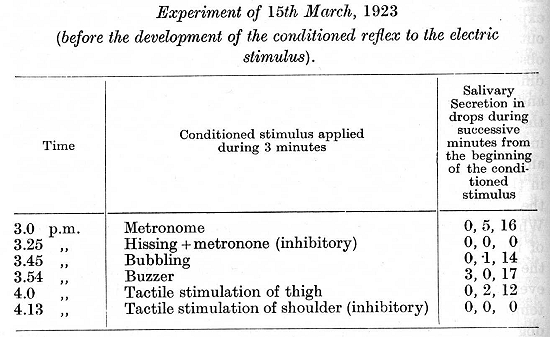
In reference to this experiment it should be mentioned that in excitable dogs the commencement of conditioned stimuli, especially strong ones, always elicits a brief investigatory reflex. On this account, in the case of delayed reflexes, there is often observed an initial short dis-inhibition of the inhibitory phase (3.54 p.m.).
The development of the conditioned reflex to the electric stimulus was begun towards the end of March. In April it was already fully established. During the whole time before the electric stimulus had been given any considerable strength all the forms of inhibition remained practically unaffected. In August the electric current was considerably increased in strength, and now the delayed reflexes became disturbed and the conditioned inhibition became incomplete. In order to diminish the inhibitory stress all conditioned stimuli excepting the buzzer were now allowed to act for 30 seconds only, instead of three minutes, before reinforcement. In spite of this, and in spite of the disuse of the "alimentary" electric stimulus, the gradual weakening of all inhibitory processes continued. The delay disappeared altogether; the hissing, which, when preceding by 5 seconds the action of the metronome had established an [p. 297] inhibitory combination, now itself acquired excitatory properties, i.e. became a conditioned stimulus of the second order. Even the differentiation of the tactile stimuli was now considerably dis-inhibited.
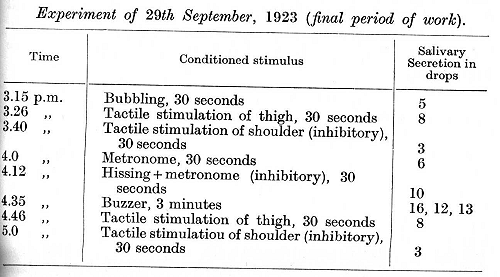
In the case of the inhibitable dog the conditioned stimuli were the same. The following experiment illustrates the conditioned reflexes as they were before the development of the reflex to the electric stimulus:
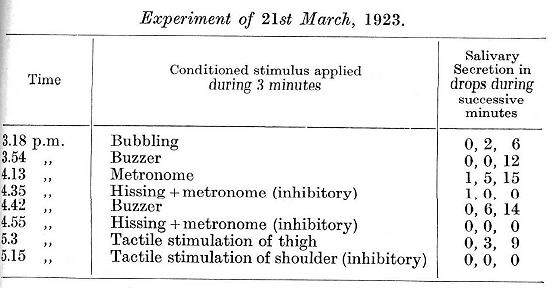
The development of the conditioned reflex to the electric stimulus was begun in this dog also towards the end of March. The reflex developed easily and soon reached a magnitude of 7 drops during 30 seconds. The defence reaction occasionally returned when the [p. 298] current was increased in strength, but finally it disappeared altogether and was entirely replaced by a typical alimentary reaction. It was soon noticed on repeating the already established reflex to the electric current that its secretory effect began to diminish, while the secretory effect of other stimuli had practically disappeared, being present only at the beginning of the experiment and in a very weak form.
The following serves as an illustration of this period of the experiments:
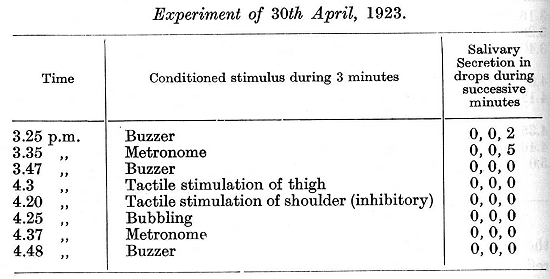
The animal started at this time to lose weight and became very dull. All experiments were therefore interrupted for a considerable time, and the dog was given plenty of food and cod-liver oil. It soon picked up weight, and its general alertness also increased. After this period of interruption all the long-delayed conditioned reflexes excepting the one to the buzzer were shortened to delays of 30 seconds. The ultimate result remained, however, unchanged. No more than indications of the positive reflexes were obtained. The electrical stimulus still evoked a considerable secretion, but on increasing its strength the reflex again diminished and finally disappeared altogether. The other positive conditioned reflexes had long since disappeared, and now all the forms of internal inhibition began gradually to disappear also, a salivary secretion being evoked on some occasions by the inhibitory stimuli.
The following experiment illustrates this condition and shows that the stimulus for the long-delayed reflex (buzzer) produced a positive effect during the formerly inhibitory phase and had no effect during the formerly positive phase. [p. 299]
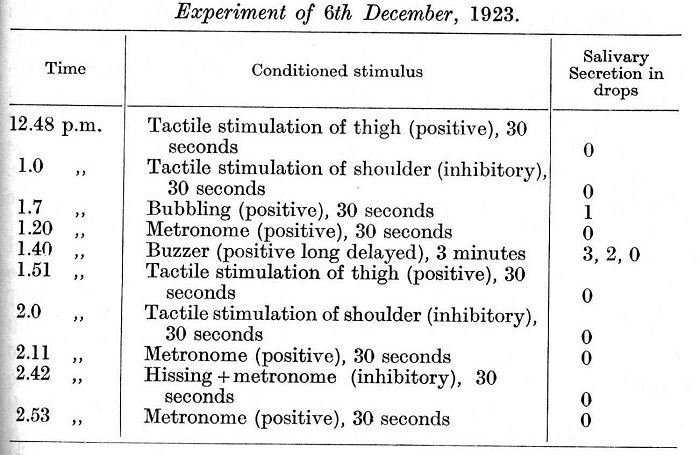
The positive effect of the formerly inhibitory stimuli did not depend upon a weakening of the inhibitory process but was determined by disturbances in the excitatory process, appearing in the form of the ultra-paradoxical phase of the cortical elements (see p. 275).
The general condition of the dog during this period of the experiments was quite satisfactory. It was found in other experiments that the differentiation and the conditioned inhibition were also weakened, giving place to a salivary secretion.
The experiments just described show that in these two dogs, with different types of nervous system, prolonged disturbances of the higher nervous activity which developed under precisely identical injurious influences took quite different directions. In the excitable dog the inhibitory function of the cortical elements became extremely weakened. In the quiet dog it was the excitation of the corresponding cells (since the stimuli were identical) which became extremely weak. In other words, two quite different types of neurosis were produced.
The experimentally developed neuroses were in both cases extremely persistent and prolonged, and even after a break in the experiments they showed no tendency to improve. It was now resolved in the case of the excitable dog to employ a valuable therapeutic agent, namely, bromides, since in our early experiments [Drs. Nikiforovsky and Deriabin] a strengthening of inhibition was sometimes observed under the action of bromides in cases where the [p. 300] internal inhibition was weak. Therefore, after the state of neurosis had continued for several months the animal was given 100 cc of 2% solution of potassium bromide daily in the form of an enema. It was soon observed that all the forms of internal inhibition began quickly to re-establish themselves and in a definite sequence. The first to recover completely was the tactile differentiation; this was followed by the conditioned inhibition, and finally by the delay. All the reflexes had returned to normal by the tenth day of the treatment.
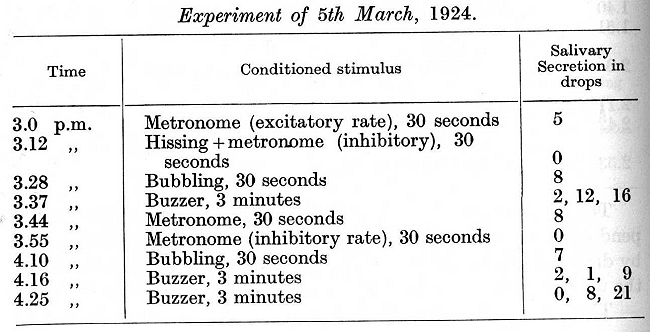
It must be noted that as a result of administration of bromides there was no diminution in the magnitude of the positive reflexes. On the contrary they were extremely constant. According to these and all our previous experiments bromides should not be regarded as sedatives diminishing the excitability of the central nervous system: they simply regulate the activity of the nervous system by strengthening the intensity of internal inhibition.
Bromides were administered for eleven days only, but the cure of the neurosis was permanent and all reflexes remained normal for the remaining 2 1/2 months of our experimentation. The state of neurosis of the "phlegmatic" dog was not improved by the administration of bromides, nor by other therapeutic measures which were tried. The animal was therefore left alone for a very long time, and little attention was paid to it. At the end of this period we were surprised to find that the animal had spontaneously and completely recovered. We shall come across further experiments with this dog in the next lecture.
Footnotes
[1] Experiments which have been communicated briefly at the Edinburgh International Congress of Physiology (1923) upon hereditary facilitation of the development of some conditioned reflexes in mice have been found to be very complicated, uncertain and moreover extremely difficult to control. They are at present being subjected to further investigation under more stringent conditions. At present the question of hereditary transmission of conditioned reflexes and of the hereditary facilitation of their acquirement must be left entirely open.